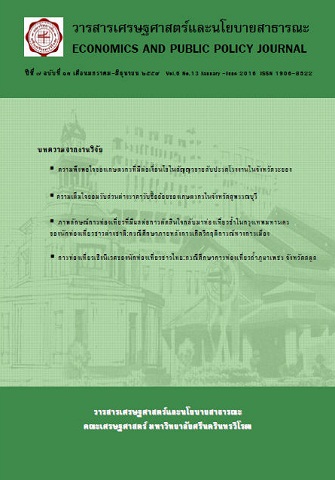ความเต็มใจยอมรับส่วนต่างราคารับซื้ออ้อยของเกษตรกรในจังหวัดสุพรรณบุรี
Main Article Content
บทคัดย่อ
การเผาอ้อยก่อนตัดนั้นเป็นสาเหตุให้เกิดผลกระทบต่อสิ่งแวดล้อมและคุณภาพของอ้อยเป็นอย่างมาก คณะกรรมการอ้อยและน้ำตาลทรายได้เล็งเห็นถึงปัญหาการตัดอ้อยไฟไหม้ จึงได้ออกมาตรการในการหักเงินอ้อยไฟไหม้เพื่อที่จะนำมาเฉลี่ยจ่ายคืนให้แก่ชาวไร่อ้อยที่ส่งอ้อยสดเข้าโรงงาน โดยทำให้เกิดส่วนต่างราคาอ้อยไฟไหม้และอ้อยสดสูงสุด 90 บาทต่อตัน แต่ก็ยังไม่สามารถแก้ไขปัญหาการตัดอ้อยไฟไหม้ของเกษตรกรได้ การวิจัยนี้จึงมีวัตถุประสงค์หลักเพื่อประเมินความเต็มใจยอมรับส่วนต่างและวิเคราะห์ปัจจัยที่มีผลต่อความเต็มใจยอมรับส่วนต่างราคารับซื้ออ้อยในพื้นที่จังหวัดสุพรรณบุรี โดยใช้วิธีการสมมุติเหตุการณ์ประเมินค่าโดยใช้แบบสอบถามแบบปลายปิดสองราคา (Double Bounded CVM) สัมภาษณ์กลุ่มเกษตรกรผู้ที่เต็มใจตัดอ้อยไฟไหม้จำนวน 194 ตัวอย่าง จากจำนวนเกษตรกรผู้ตัดอ้อยไฟไหม้ 250 ราย
ผลการศึกษา พบว่า จากการประมาณค่าความเต็มใจยอมรับส่วนต่างด้วยแบบจำลอง Interval Data Model และ Bivariate Probit Model ส่วนต่างราคารับซื้ออ้อยควรอยู่ในช่วง 232.41 - 237.81 บาทต่อตัน โดยปัญหาเรื่องการขาดแคลนแรงงานและการมีโควตาส่งอ้อยเข้าโรงงานเป็นปัจจัยหลักที่ส่งผลต่อมูลค่าความเต็มใจยอมรับส่วนต่างราคาในทิศทางเดียวกัน อย่างไรก็ตามถึงแม้จะสามารถจัดการกับข้อจำกัดเหล่านี้ได้ มูลค่าส่วนต่างราคาที่เกษตรกรยอมรับจะมีมูลค่าลดลงเหลือ 177.14 บาทต่อตัน แต่ก็ยังคงสูงกว่าส่วนต่างราคาในปัจจุบัน
ดังนั้นผลของการศึกษานี้ จะสะท้อนให้เห็นถึงส่วนต่างราคาที่เกษตรกรยอมรับซึ่งสูงกว่าตัวชี้วัดมูลค่าส่วนต่างราคาในปัจจุบัน คณะกรรมการอ้อยและน้ำตาลทรายสามารถใช้ผลของการศึกษานี้เป็นแนวทางในการปรับปรุงนโยบายในการแก้ไขปัญหาเรื่องการตัดอ้อยไฟไหม้ต่อไปในอนาคต
Willingness to Accept Sugar Cane Price Difference of Farmers in Suphan Buri Province
Pre-harvest burning of sugar cane has impacts on both environment and sugar cane quality itself. Therefore Office of the Cane and Sugar Board (OCSB) has issued measure to deduct the price from burning sugar cane and distribute the collected money back to fresh-cut sugar cane resulting in maximum price difference between pre-harvest burning and fresh-cut sugar cane up to 90 bath/ton. However, this measure still could not reduce the amount of pre -harvest burning of sugar cane. This study aims to evaluate the price difference that farmers’ willingness to accept (WTA) to change from pre-harvest burning to fresh-cut sugar cane and factors affecting WTA. Double Bounded Closed-Ended Contingent Valuation Method (CVM) was employed to evaluate farmers’ WTA based on 194 pre-harvest burning sugar cane farmers who are willing to burn from 250 pre-harvest burning sugar cane farmers.
The results reveal that the price difference should be between 232.41 – 237.81 Baht/ton based on Interval data model and Bivariate probit model. The main factors that affect WTA are labor shortage and sugar cane quota leaders. However, if these restrictions are removed, the required price difference is reduced to 177.14 Baht/ton which is still higher than the current maximum price difference.
The finding from this study reflects that farmers’ acceptable price difference is much higher than the current measure. OCSB could be used these results as a guideline for developing the policy to solve Pre-harvest burning of sugar cane in the future.
Article Details
สงวนลิขสิทธิ์ © 2553 คณะเศรษฐศาสตร์ มหาวิทยาลัยศรีนครินทรวิโรฒ
คณะเศรษฐศาสตร์ มหาวิทยาลัยศรีนครินทรวิโรฒ จัดพิมพ์วารสารเศรษฐศาสตร์และนโยบายสาธารณะ เพื่อเผยแพร่บทความวิชาการทางเศรษฐศาสตร์ นโยบายสารธารณะ และสาขาอื่นๆที่เกี่ยวข้อง ทัศนะและข้อคิดเห็นใดๆ ที่ปรากฏในวารสารเป็นความคิดเห็นส่วนตัวของผู้เขียน โดยบทความที่ได้รับการตอบรับจะถือเป็นลิขสิทธิ์ของคณะเศรษฐศาสตร์ มหาวิทยาลัยศรีนครินทรวิโรฒ
บรรณาธิการ อาจารย์ ดร.พลพัธน์ โคตรจรัส


